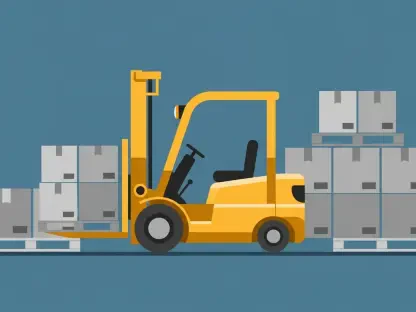Setting the Stage for a Logistics Revolution
Imagine a future where heavy goods vehicles (HGVs) glide along UK highways without a driver at the wheel, slashing operational costs and curbing emissions while ensuring goods reach their destinations with unprecedented precision. This vision is no longer a distant dream but a tangible prospect as the UK government, alongside industry pioneers, channels significant funding into the eFREIGHT Autonomous project. Supported by Innovate UK and Zenzic through the CAM Pathfinder Feasibility Studies Competition, this initiative stands as a beacon among 14 selected projects, aiming to dissect the potential of autonomous HGVs within fleet operations. The stakes are high, with the freight sector grappling with tight margins and labor shortages, making this market analysis a critical exploration of how autonomy could reshape logistics.
Diving Deep into Market Trends and Autonomous HGV Potential
Current Landscape: Freight Industry Challenges Meet Technological Promise
The UK freight sector is at a pivotal juncture, burdened by escalating fuel costs, driver scarcity, and mounting pressure to meet net-zero targets. These challenges have created fertile ground for technological intervention, with autonomous HGVs emerging as a potential game-changer. Early trials of connected and automated mobility (CAM) solutions, such as self-driving shuttles in urban centers and autonomous buses in select regions, have already demonstrated the viability of driverless technology in controlled environments. The eFREIGHT Autonomous project builds on this momentum, focusing on adapting such innovations for the high-stakes world of heavy freight transport, where efficiency and reliability are paramount.
Moving beyond small-scale experiments, the industry is witnessing a surge in interest from stakeholders eager to capitalize on automation’s promise of reduced labor costs and optimized routes. The consortium behind eFREIGHT, comprising leaders in electric vehicle technology and commercial vehicle design, is tasked with benchmarking UK capabilities against global frontrunners like China and the US, where autonomous trucks are already operational in specific zones. This comparative analysis is crucial for identifying gaps in technology and readiness that could hinder market penetration if left unaddressed.
Technological Frontiers: Assessing Readiness and Barriers
Delving into the technological sphere, the eFREIGHT Autonomous study is meticulously evaluating the maturity of self-driving systems for HGVs. Current advancements show promise, with sophisticated sensors and machine learning algorithms capable of navigating complex road scenarios. However, significant hurdles remain, including ensuring safety across diverse weather conditions and seamless integration with existing traffic infrastructure. The project aims to forecast how these technologies might evolve over the next few years, providing a roadmap for overcoming technical limitations that could stall widespread adoption.
A key concern is the reliability of autonomous systems in unpredictable environments, such as rural roads or densely populated urban areas. The analysis also considers the risk of cybersecurity threats, given the connected nature of these vehicles, which could expose fleets to hacking or data breaches. By addressing these challenges head-on, the initiative seeks to build confidence among fleet operators, ensuring that technological solutions are not only innovative but also robust enough for real-world application.
Commercial Viability: Weighing Costs Against Gains
From a commercial perspective, the allure of autonomous HGVs lies in their potential to transform the economics of freight transport. With profit margins often razor-thin, the prospect of cutting driver-related expenses and enhancing fuel efficiency through optimized routing is highly attractive. The eFREIGHT study is zeroing in on specific use cases, such as long-haul deliveries or repetitive depot-to-depot transfers, to pinpoint where automation yields the highest return on investment for operators.
Yet, the path to profitability is not without obstacles. High upfront costs for autonomous systems and the need for supporting infrastructure, such as smart traffic networks, pose significant barriers to entry. The analysis will also explore how government incentives or subsidies could offset these expenses, making the transition more feasible for small and medium-sized enterprises. This balanced examination of costs versus benefits is essential for crafting a sustainable business model that can drive market acceptance.
Infrastructure and Policy: Building the Foundation for Market Growth
Infrastructure readiness and regulatory frameworks form another critical pillar of the eFREIGHT Autonomous analysis. The UK’s diverse road network, with varying conditions from urban centers to remote highways, complicates the deployment of autonomous HGVs. The study is delving into the need for upgrades like dedicated lanes or advanced traffic management systems to facilitate safe and efficient operations across regions.
On the policy front, the impending full implementation of legislation governing automated vehicles by 2027 adds urgency to aligning market strategies with legal requirements. Insights from data and research partners within the consortium highlight the importance of public trust and safety standards in shaping these policies. Addressing misconceptions, such as fears of widespread job losses, is also vital, with the project framing automation as a means to augment rather than replace human roles in logistics, thereby fostering a supportive environment for market expansion.
Future Projections: Market Shifts by 2027 and Beyond
Looking ahead, the trajectory for autonomous HGVs in the UK points toward transformative growth within the freight sector by 2027. The eFREIGHT Autonomous initiative anticipates delivering detailed reports and actionable timelines in the coming years, potentially paving the way for real-world trials on public roads. Industry forecasts suggest that combining autonomy with electrification trends could result in a dual revolution, where HGVs are not only self-driving but also zero-emission, aligning with broader sustainability goals.
Economic factors, such as potential government backing for green technologies, are likely to accelerate market adoption, while regulatory clarity will further reduce uncertainty for investors. The projected timeline indicates that operational autonomous HGVs could become a reality within the next two years, setting a global benchmark for freight innovation. This forward-looking analysis underscores the sector’s readiness to embrace change, provided the right technological and policy supports are in place.
Reflecting on Insights and Charting the Next Steps
Looking back, the comprehensive market analysis conducted through the eFREIGHT Autonomous project illuminated the immense potential of autonomous HGVs to redefine the UK freight landscape. It revealed critical gaps in technology, commercial models, and infrastructure that need bridging to ensure successful integration. The collaborative efforts of industry and government stakeholders underscored a shared commitment to tackling these challenges with innovation and foresight.
For fleet operators, the path forward involves investing in pilot programs and forging partnerships with technology developers to stay ahead of the curve. Policymakers, on the other hand, are encouraged to prioritize infrastructure investments and refine regulatory frameworks based on the detailed findings from feasibility studies. By acting on these strategic recommendations, the industry can turn the promise of autonomous logistics into a concrete reality, enhancing efficiency and sustainability for future generations.









